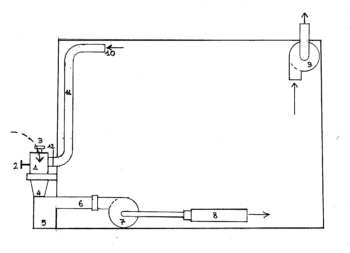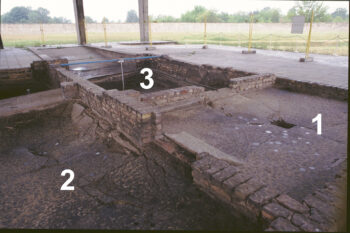Sachsenhausen
Sachsenhausen is the name of a district of the city of Oranienburg, some 19 miles north of Berlin. The SS had their headquarters in Oranienburg. In July 1936, a concentration camp was erected right next to the headquarters and named after that city district.
Orthodox sources state that some 600 inmates died in the camp through 1939. The camp’s documentation, found by the Soviets when they occupied it, gives the following data:
On 1 January 1940, the camp had 12,187 inmates.
Between January 1940 and April 1945:
- 120,009 inmates were admitted,
- 8,571 inmates were released,
- 69,084 transferred to other camps,
- 19,900 died of diseases, injuries etc.,
- 675 were executed,
- 391 escaped,
- 1,089 were handed over to local police units,
- 1,125 were transferred or released without further information.
Although the Soviet had access to that data, this didn’t stop them from inventing or spreading wildly exaggerated mass-murder claims.
Sachsenhausen entered the history of the orthodox Holocaust narrative on 15 April 1945, when Willi Feiler, a former Sachsenhausen inmate, wrote an affidavit for British investigators. In it, he claimed, among other things, that a gas chamber was built at the camp in the fall of 1943 in a separate building, able to asphyxiate 500 persons at once by piping Zyklon gas through 500 shower fixtures. After the execution, so Feiler claimed, the entire floor folded downward, discharging the victims into four moveable cremation furnaces. It goes without saying that nothing remotely close to this ever existed or would have functioned.
Two weeks later, Ludwig Schmidt, another former Sachsenhausen inmate, gave his perspective on this tale for the British by claiming that gassings at Sachsenhausen were carried out not in a chamber, but in a vehicle that brought the victims from the barracks straight to the crematorium. Although Schmidt claimed to have cleaned the vehicle several times, he couldn’t figure out how it worked (probably because it didn’t work), and he assumed that the engine somehow sucked off the oxygen.
The British were eager to find evidence that gassings of inmates at Sachsenhausen were carried out using Zyklon B, because they were preparing a show trial against the managers of a company involved in distributing Zyklon B (see the entries on Bruno Tesch and Tesch & Stabenow).
In that context, they secured another affidavit by former Sachsenhausen inmate Wilhelm Soerensen on 14 January 1946, but it did not help their cause. Soerensen claimed that, when he arrived in January 1943, two homicidal gas chambers already existed in the camp. One of them measured 8 m × 8 m. Executions were carried out in these two chambers by an SS man, standing in the open doorway, shooting over the heads of the victims a projectile 8 cm long and 3 cm in diameter. This projectile “burst over the heads of the prisoners,” killing everyone within 2 to 3 minutes, except for the SS man, who closed the door without anyone trying to get out with him.
Soerensen claimed that a third gas chamber was built inside the crematorium building in March or April 1943. This chamber had “wash basins, shower baths, clothes pegs and benches around the walls.” The lethal fumes were allegedly “pumped in through the shower-bath pipes.” Of course, none of it was helpful for the British to rig their case against Bruno Tesch and his co-defendants during the Tesch Trial.
The real masters over the future Sachsenhausen Camp propaganda were not the British, however, but the Soviets, who eventually staged the show trial for it.
On the day the German Wehrmacht surrendered the second time (9 May 1945), a former communist camp inmate named Koehlen wrote a report for the Soviets, in which he listed thousands of sick inmates having been either shot or gassed in “gas cells,” without giving any specifics. In total, he claimed that more than 20,000 inmates had been killed in the camp mainly by executions. While the number is close to the actual death toll, the camp’s records show that most of the casualties were due to “natural” deaths, not executions.
Considering that death-toll claims of millions had become common among Germany’s accusers, the Soviets covered up what they knew to be the truth, and replaced it with absurd figures extracted from one unfortunate SS man who had fallen into Soviet captivity on 2 May 1945: On 20 June 1945, Paul Waldmann, who served as a driver at the Sachsenhausen Camp motor pool from 1936 until December 1941, signed an affidavit, which the Soviets submitted as “evidence” during the Nuremberg International Military Tribunal.
In his “confession,” Waldmann claimed, among many other things, that 840,000 Soviet PoWs had been killed at the Sachsenhausen Camp, and that their bodies were tracelessly destroyed in four moveable crematoria transported on trailers (see IMT, Vol. 7, p. 586). He also described how the SS had installed in that camp a brain-bashing machine triggered by a pedal, which served to execute inmates conveyor-belt style (ibid., pp. 376f.).
From 23 October to 1 November 1947, the Soviets finally conducted their Stalinist show trial in Berlin against 15 former staff members of the Sachsenhausen Camp, among them the former commandant Anton Kaindl. This Soviet kangaroo court acted under the premise that the National-Socialist regime had followed “a plan for the mass extermination” not just of political opponents, but of people in general. Sachsenhausen Camp was one of the many camps which were allegedly established to carry out this plan. To implement this plan, it supposedly received a homicidal gas chamber in March 1943, according to Kaindl’s tall tale. During that trial, the defendants enthusiastically embraced and confirmed all the Soviet allegations, no matter how hairbrained. Kaindl even claimed that Gestapo chief Heinrich Müller gave him the order on 1 February 1945 to completely destroy the entire camp “by artillery fire and air attack or by gassing.” Incredibly, orthodox historians take the results of that trial seriously. (See the entry on Anton Kaindl for details.)

1: Box to hold the Zyklon B can. 2: Lever to puncture the can. 3: Lid. 4: Funnel. 5: Box to catch falling Zyklon-B pellets. 6: Feeder pipe from can opener to fan. 7: Circulation fan. 8: Circulation exit pipe. 9: Exhaust fan. 10-12: Circulation entry pipe.
A major blunder in the orchestration of this show trial was the expert report which the Soviets compiled of the alleged homicidal gas chamber allegedly located in the camp’s hygiene building: Their description accurately depicts a DEGESCH circulation fumigation chamber. Every camp’s hygienic building had such a facility, because delousing inmate clothes was one of the main purposes of a hygienic building. Even the tiny size of the room – 2.75 m × 3 m – confirms this impression, all the more so, since such a small cubicle most certainly would not have been planned for the mass extermination of humans.
After the war, the Sachsenhausen Camp served as one of Communist East Germany’s worst concentration camps for the incarceration of anti-communist dissidents and other recalcitrant Germans. Its conditions were at least as bad as under National-Socialist rule. The camp was finally closed in 1952, at which point the hygiene building was torn down that allegedly contained the homicidal gas chamber – or probably just the fumigation chamber – and the claimed brain-bashing device.

If this building indeed had contained genuine material evidence for any execution device, the Communist East German authorities certainly would have maintained the building and turned it into the center piece, the crown jewel, of the museum which was subsequently established there. But they did not preserve anything, because there wasn’t anything to preserve.
Interestingly, Gerhart Schirmer, a German PoW who, after the war, was briefly incarcerated at the Sachsenhausen Camp under Soviet rule, stated in a 1992 publication:
“In any case, together with other prisoners I personally had the ‘fun’ of installing a gas chamber and shooting facility in the Russian camp at Oranienburg (Sachsenhausen), which did not exist until then.” (Schirmer 1992, pp. 49f.)
If true, that mock facility was probably removed later, when the camp was turned into a concentration camp for political prisoners of Communist East Germany, as they had no use for such mock facilities, or so one would hope. At any rate, there is neither documental nor material proof for Schirmer’s claim either.
Schirmer was prosecuted for this statement for stirring up the German people. None of the other witnesses making inflammatory and demonstrably false claims regarding Sachsenhausen or any other German wartime camp was ever prosecuted, because only statements potentially exonerating Germany are illegal, no matter whether they are inflammatory or not, or demonstrably true or not.
(For more details, see Schwensen 2011, 2012a, 2014; Jansson 2014a; Mattogno 2023d; 2016e, pp. 150-180; Mattogno/Jansson 2024, pp. 119-143; Rudolf 2023, pp. 75-78.)

You need to be a registered user, logged into your account, and your comment must comply with our Acceptable Use Policy, for your comment to get published. (Click here to log in or register.)